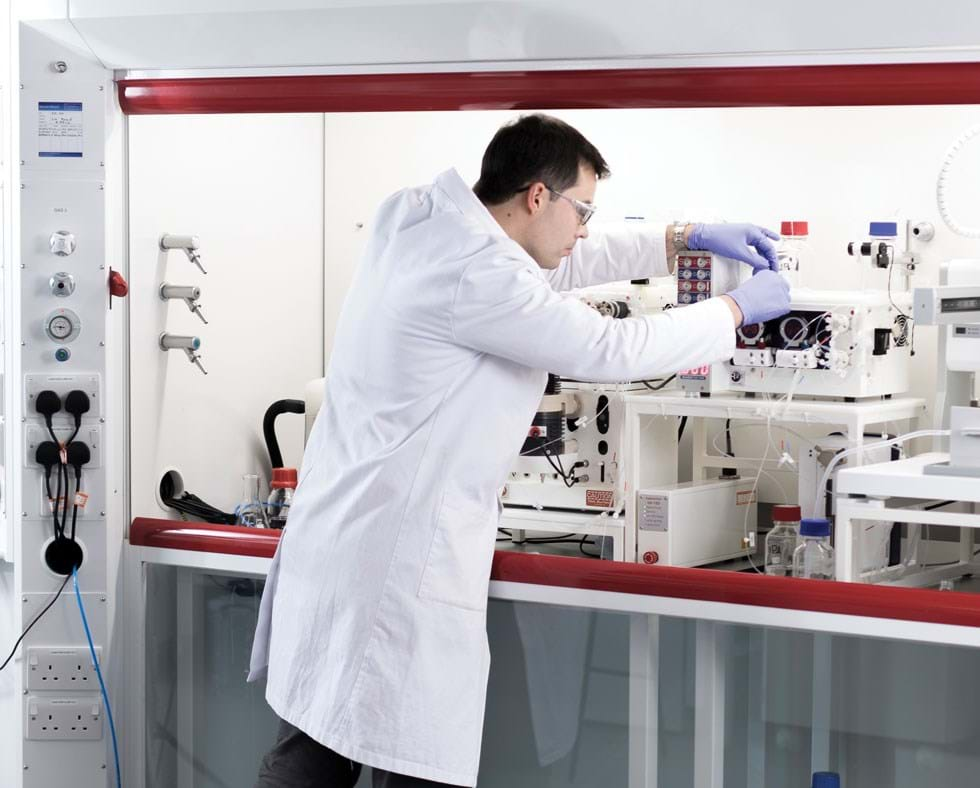Our Research Focus: Going with the Flow Chemistry
Christian Holtze and Klaus Hellgardt on how the newly established IConIC consortium is aiming to seize the opportunities presented by flow chemistry and implement them on a commercial scale
SINCE the inception of the chemical industry over one-and-a-half centuries ago, it has remained remarkably unchanged: fuelled by fossil resources, commodities are churned out in large-scale continuous processes, while speciality chemicals are predominantly batch-produced due to lower development costs. Global supply chains have prioritised cost minimisation above all else. However, these established practices are now undergoing a seismic shift. The disruption of supply chains during the pandemic has underscored the necessity for enhanced resilience, while achieving net zero goals and addressing the scarcity of natural gas in Europe demand a transition from fossil fuels to renewable energy and circular economy feedstocks.
In response, the UK’s Engineering and Physical Sciences Research Council (EPSRC) is allocating public funding to incentivise research addressing these issues, with the industry-led Prosperity Partnership Programme focusing on early-stage research conducted in academia. Last July, a collaboration spearheaded by BASF commenced at Imperial College London alongside a consortium of five industrial partners and the Centre for Process Innovation (CPI). Coined IConIC (Innovative Continuous Manufacturing of Industrial Chemicals), our partnership aims to address the challenges of implementing flow chemistry across the entire industrial research and development workflow, encompassing laboratory, pilot, and production scales.
Drawing upon the renowned expertise of the UK’s flow chemistry community, IConIC is set to run for five years with a total budget of £17.8m (US$22.8m).
What is flow chemistry?
Continuous processing is a highly automated 24/7 manufacturing process used in BASF plants that produce large quantities of products, such as commodities. For products that are produced in smaller quantities (eg fine and speciality chemicals, crop protection actives), the less automated, but more flexible manufacturing in batch is standard. Flow chemistry aims at producing such products in a continuous process on a smaller scale than state-of-the-art world-scale commodity processes; it also encompasses continuous operation on the lab and pilot scale.
Opportunities for flow
Continuous processing offers a variety of advantages over batch processing, which is why most commodity chemicals are produced in a continuous manner. This method allows for tight control of process conditions, resulting in consistent product quality, often with improved yield and selectivity. Additionally, continuous processing enables access to more extreme reaction conditions, such as flash conditions, as it permits rapid heating and cooling and can handle high pressures. Furthermore, reactions involving hazardous intermediates can be managed more safely due to the smaller hold-up volume compared to batch processing. Operating costs are also lower for continuous processes, as setup time and labour are minimal in comparison.
However, developing a continuous process currently requires more effort in research and development. This is partly due to the absence of specialised equipment and expertise in many laboratories and pilot facilities. The landscape is changing, though, as a growing number of scientists graduate from academic institutions with relevant expertise, and commercially available flow equipment becomes more accessible for numerous unit operations.
Key UK companies at the forefront of this advancement include Uniqsis, Syrris, and Vapourtec, offering modular building blocks including benchtop flow reactors, pumps, back pressure regulators, and product collectors. AM Technology and NiTech are also playing significant roles in this evolving field, with advancements in digital technology complementing flow technology and helping to facilitate integration into industry.
Nevertheless, we understand that managing this transition within established industrial research and development organisations remains challenging. In our view, successful adoption relies on clearly communicating a business need and opportunity that justifies significant investment in new assets.
Our partnership aims to address the challenges of implementing new flow technology across the entire industrial research and development workflow, encompassing laboratory, pilot, and production scales

Value of flow chemistry for commercial deployment
The transition from batch to continuous production is driven by various factors, which depend on the specific product or production process. In the pharmaceutical industry, ensuring product quality and consistency is a primary motivation. On the other hand, for speciality chemicals produced at scales ranging from 100–100,000 t/y, environmental, health, and safety (EHS) considerations play a significant role. Continuous processes offer enhanced process safety due to smaller hold-up volumes of hazardous intermediates compared to batch processes. In some cases, regulators have mandated the use of continuous flow for certain conversions. Whereas the development and scaleup of nitration processes for agrochemical intermediates has traditionally involved batch production at lab- and pilot-scale, regulation in China is triggering a shift to continuous production at commercial scale. American multinational Corning claims this is a major pillar in the industrial adoption of their bespoke modular process kit, which allows researchers to develop a flow process and suitable operating parameters using continuous methods from the outset.
Generally, with larger product volumes the importance of raw material cost, yield, and selectivity increases. As outlined earlier, continuous processing generally offers lower operating expenditures and, when operated in a steady state, typically produces less undesired side-products, reducing the need for costly separation steps. From a sustainability perspective, continuous operation provides significantly better opportunities for heat integration.
The shift towards net zero emissions will make distributed manufacturing of chemicals appealing, particularly for processes that utilise CO2 as a feedstock (carbon capture and utilisation (CCU)) or require significant amounts of electrical energy or hydrogen. Such plants will be operated next to the CO2 emitter or solar farm/windfarm, respectively and are likely to be smaller in scale than traditional world-scale facilities. Their operation may involve remote control, necessitating highly autonomous continuous processes.
For situations where an optimised set of processing parameters and time to market are crucial, screening in flow (see also SOLVE on page 41) enables the collection of detailed datasets, offering potential for machine learning-assisted research and development. Understanding the heat and mass transfer characteristics of small-scale continuous equipment or even the intrinsic kinetics allows chemical engineers to scale up processes more efficiently than with large-scale batch processes. To facilitate swift process development, a number of equipment vendors offer reactors at various scales designed for direct transfer to larger scales (eg Corning, NiTech, and AMTechnology).
It is important to note that while flow chemistry offers numerous benefits, there are also drawbacks, mainly related to the need for investment into specialised equipment and reduced versatility compared to batch processes.
Managing change
We believe that to successfully introduce new technology into production, effective change management is essential, as there are numerous obstacles to innovation. One significant challenge we see is how to navigate the transition from academic research to industrial R&D. Often, industrial research facilities lack the necessary equipment and expertise to capitalise on promising findings from academic research, particularly if they have historically focused on batch processes. This gap persists at the pilot scale and can impede deployment on the production scale, especially when existing multi-purpose batch plants, which may have unused capacity, are in place. Consequently, access to equipment, infrastructure, and expertise poses a challenge throughout the entire research and development process.
Moreover, the adoption of flow technology depends on organisational changes that facilitate its seamless integration into industrial workflows across all stages of development. Effective interfaces must be established to facilitate the transition from academic research to industrial labs, pilot facilities, and ultimately production. This necessitates engaging a wide range of stakeholders, including scientists, engineers, and business professionals, who occupy various roles and levels within the company. Each stakeholder group brings a different perspective and set of requirements to the table. Therefore, garnering their support and bridging these diverse viewpoints is crucial for the successful implementation of process innovations in the chemical industry.
“The connection between business and academia is essential as we learn so much by listening to each other,” says Darren Budd, commercial director, UK & Ireland at BASF. “Our IConIC Prosperity Partnership will be a key project to demonstrate how we can come together to co-create and co-deliver research and innovation that address industry challenges and deliver economic and societal impact.”

Tackling valleys of death
Capitalising on the longstanding collaboration between BASF and various departments at Imperial, IConIC adopts an interdisciplinary approach, merging the understanding of a chemical reaction and the engineering of the reactor as well as the entire process with advanced digital capabilities such as data science. Additionally, it incorporates technoeconomic benchmarking, life cycle assessment (LCA), and considerations of value and supply chains, all crucial for informed investment decisions.
To achieve this, we have built an interdisciplinary community comprising over 60 industrial scientists, academic principal investigators (PIs), and doctoral students/postdoctoral researchers. We have brought together an industrial consortium, strategically selected along the value chain, that includes Almac and Sterling (contract development and manufacturing organisations), Siemens PSE (software), Mettler-Toledo (analytical equipment and modelling), and AM Technology (equipment manufacturing), thus assembling a diverse array of complementary expertise.
Under the framework of EPSRC’s Prosperity Partnership scheme, industrial and academic stakeholders pool their expertise in collaborative efforts to advance critical capabilities in the field. This partnership aims to drive disruptive innovation, ultimately delivering commercially viable solutions for societal and environmental benefit – “a prime example of how the triple helix of public, private, and academic sectors can work seamlessly to advance chemical engineering in the age of net zero,” according to Omar Matar, Imperial’s head of department of chemical engineering.
If IConIC succeeds we will have developed and demonstrated new flow chemistry and holistic methodologies, which can be implemented by the speciality chemicals sector to produce performance chemicals and actives faster, cleaner, and more economically.
A pivotal milestone identified by IConIC is the decision to invest in production assets based on novel processes. In industry this decision must be meticulously informed, considering technical, economic, and sustainability factors. Hence, the final goal of IConIC is to offer investors, companies, and government agencies a detailed value proposition for adopting flow chemistry. While IConIC’s holistic R&D workflow aims to quantify and mitigate risks; the comprehensive information package will be the basis for favourable investment decisions. This rationale cascades into specific goals and sub-research programmes, termed “Collaborative Lighthouse Programs”, managed by dedicated BASF experts in close collaboration with academic PIs:
Recent Editions
Catch up on the latest news, views and jobs from The Chemical Engineer. Below are the four latest issues. View a wider selection of the archive from within the Magazine section of this site.




